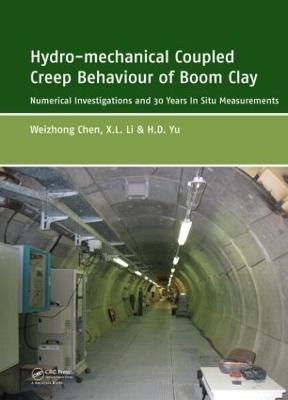
Hydro-mechanical Coupled Creep Behaviour of Boom Clay
Numerical Investigations and 30 Years In Situ Measurements
Seiten
2023
CRC Press (Verlag)
978-0-415-65643-6 (ISBN)
CRC Press (Verlag)
978-0-415-65643-6 (ISBN)
- Titel ist leider vergriffen;
keine Neuauflage - Artikel merken
Creep behaviour, especially for underground radioactive waste disposal facilities, whose storage period far exceed the service time of most of the civil engineering underground facilities, is very significant. Boom Clay, an argillaceous rock chosen as a reasonable geological barrier in Belgium is first systematically studied in this book. A series of research tools such as laboratory experiments (4 years), field measurements (20 years), theoretical studies, back analysis and numerical simulations are used to study the mechanical behavior of this rock.
Firstly, laboratory studies such as oedometer tests, HM triaxial tests, HM triaxial creep tests and SEM tests, etc. intuitively show the nonlinear behaviour of the argillaceous rock and it provides a basis for the theoretical studies.
Secondly, considering the anisotropic mechanical properties and nonlinear creep potential of Boom Clay, a relatively complete theoretical system has been established.
Thirdly, based on the field measurements in the last few decades, using back analysis method, the theoretical studies are verified.
Finally, based on the study above, long term stability analysis of the underground disposal facilities is implemented and the risks facing future generations in the event of failure in the disposal system are also quantified through numerical simulation.
Firstly, laboratory studies such as oedometer tests, HM triaxial tests, HM triaxial creep tests and SEM tests, etc. intuitively show the nonlinear behaviour of the argillaceous rock and it provides a basis for the theoretical studies.
Secondly, considering the anisotropic mechanical properties and nonlinear creep potential of Boom Clay, a relatively complete theoretical system has been established.
Thirdly, based on the field measurements in the last few decades, using back analysis method, the theoretical studies are verified.
Finally, based on the study above, long term stability analysis of the underground disposal facilities is implemented and the risks facing future generations in the event of failure in the disposal system are also quantified through numerical simulation.
1 Introduction; 2 Laboratory tests on HM behavior of Boom clay; 3 Elasto-plastic damage model of Boom clay; 4 Mechanical creep damage model of Boom clay; 5 Back analysis on in-situ stress of HADES; 6 Back analysis on anisotropic permeability of HADES; 7 Back analysis on creep behaviour of Boom clay; 8 HM perturbation during the connecting gallery construction (CLIPEX); 9 Numerical simulation on long-term stability of HADES; 10 Conclusions; References
| Erscheint lt. Verlag | 31.12.2023 |
|---|---|
| Verlagsort | London |
| Sprache | englisch |
| Maße | 174 x 246 mm |
| Themenwelt | Technik ► Bauwesen |
| Technik ► Umwelttechnik / Biotechnologie | |
| ISBN-10 | 0-415-65643-5 / 0415656435 |
| ISBN-13 | 978-0-415-65643-6 / 9780415656436 |
| Zustand | Neuware |
| Haben Sie eine Frage zum Produkt? |
Mehr entdecken
aus dem Bereich
aus dem Bereich
Grundlagen und Vorgehensweisen
Buch | Softcover (2021)
Springer Fachmedien Wiesbaden GmbH (Verlag)
37,99 €
Bemessung von Stahlbauten nach Eurocode mit zahlreichen Beispielen
Buch | Hardcover (2024)
Springer Vieweg (Verlag)
59,99 €
Buch | Softcover (2024)
Springer Vieweg (Verlag)
18,99 €


